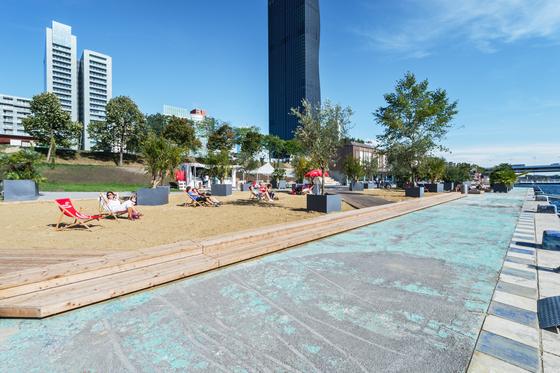Skatepark, Malmö
Skater/architect Stefan Hauser has designed and built an undulating harbourscape.
Some harbours expand; others shrink as they disappear from the focus of the global economy. Malmö’s Västra Hamnen harbour has been in steady decline since the 1970s. However, in the ten last years the reclaimed tundra – a very exotic feature in the Swedish landscape – has been transformed into a post-industrial landscape. The last and biggest of the landfill operations of the 1980s, intended as a parking lot for an automotive industry that failed to appear, has been reprogrammed and repopulated with a university, offices for hi-tech businesses and a new eco-themed residential district dominated by Santiago Calatrava’s phallic one-liner (Turning Torso, A10 #2). This new-found drive has been fairly successful in reshaping the city’s self-image as a modern city that has left its previous run-down, working-class aura behind it. Where the harbour front used to be, is the abandoned slipway no. 7, a combination of scaffolding and an enormous, concrete wedge of a building. The previous owner and Malmö’s pride and joy – the Kockums shipbuilding company – used to weld together oil tankers on the slipway. Too expensive and complicated to demolish and still regarded with affection, it was retained and relabelled an industrial park. Tema Arkitekter has drawn up a masterplan for the area, called Stapelbäddsparken, in which the slipway has been transformed into an activity park: climbing walls, a dash of art, areas for pétanque, concerts, et cetera, all to be completed in 2007.
The most interesting addition to this born-again area, and the only thing completed to date, is a skatepark situated just north of the slipway in the middle of the vast harbour plain. In May this year, the 2000 m² concrete landscape was officially inaugurated with a World Cup Skateboarding fixture and enthusiastically received. The designer is Oregon-based Stefan Hauser who works under the name Placed To Ride. He is not an architect by trade, but has a background of art and sculpture and – of course – skating. Hauser has gained a solid international reputation as a designer and builder of skateparks, first through the Dreampark collective, also based in skatepark-dense Oregon, and for the last few years through his own firm. What really distinguishes him from your average architect is his hands-on approach. When construction work is about to begin, Hauser relocates to the project for the duration, together with a crew of loyal friends from around the world. The skaters-cum-builders construct the whole thing themselves.
The result is impressive – a landscape of bumps, slopes and steel-rimmed edges, and the compulsory bowl: a kidney shaped pool. The immaculate concrete surfaces with smooth organic slopes look almost abstract in their improbable form. In fact, it looks much more abstract in reality than as a rendering. The slick finish would probably be unobtainable without such a completely dedicated workforce.
Skateboarding has managed to keep its freshly radical image over the years. Yet the cultural history of skating reveals a fascinating combination of avant-garde youth street culture and meticulous traditionalism when it comes to shape and form. Skating as we know it today was born in the same era and in some ways in the same context as the collapse of Malmö’s shipbuilding industry. It all began with the introduction of the soft polyurethane wheels in the early 1970s which enabled a new style of skating. Poolriding – now very common – developed during the Californian drought of the mid 1970s when some teenagers in the Santa Monica area broke into people’s backyards to skate in their empty kidney-shaped swimming pools. The Z-Boys – named after Zephyr, the local surf/skate shop – reinvented the previously inoffensive preppy sport as a skate-punk lifestyle (see Stacey Peralta’s documentary Dogtown and Z-Boys, 2001.) Around the same time Kockums was confidently announcing that they were the largest shipyard in the world; only a few years later they were out of business. In the meantime many of the Z-Boys had become leaders in the expanding international skateboard industry. As cities around the world rebrand themselves, it is interesting to note how universal and timeless skating’s street credibility seems to be.














